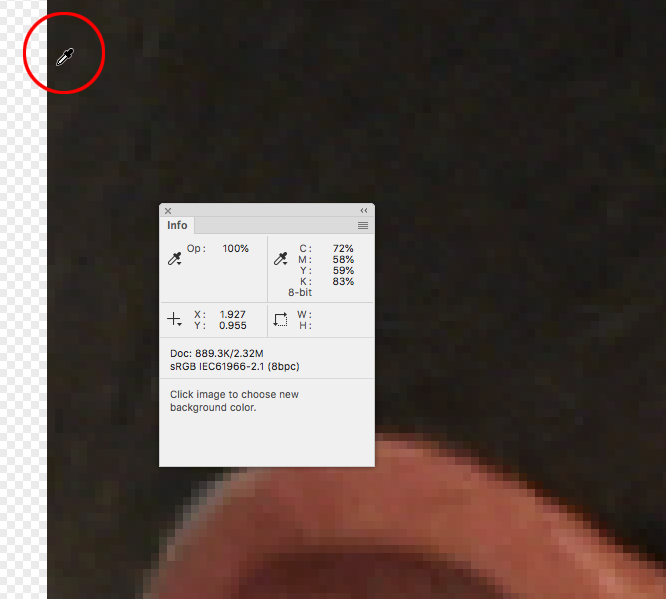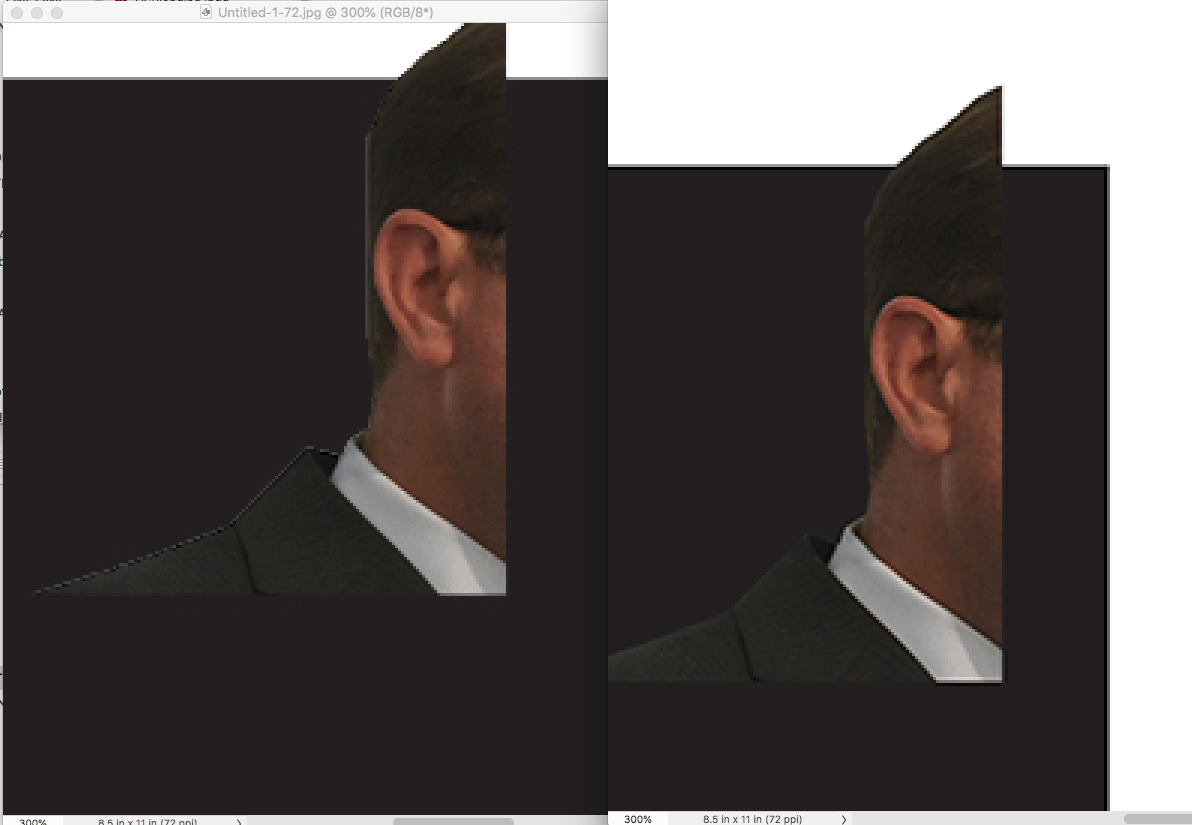- Home
- InDesign
- Discussions
- Re: artefacts on clean Photoshopfile with transpar...
- Re: artefacts on clean Photoshopfile with transpar...
artefacts on clean Photoshopfile with transparent background using inDesign
Copy link to clipboard
Copied
I am using Adobe CC on a current year Macbook Pro. I have been experiencing some issues when working with images that have a transparent background - particularly silhouetted photos/images that have had their backgrounds removed. I am seeing some white pixels surrounding the silhouetted image when I place the the PSD file into inDesign and place it over a shape with a color fill. When I export the image from inDesign as a JPG, PNG, or PDF (various types) it seems to be adding some white pixels around my silhouetted head that are not actually in the original PSD file.
I tried changing the original PSD image to a PNG and TIFF with transparency and I still experience the same problem of inDesign adding white pixels.
The image looks cleanly masked when I view it in Photoshop, and when I add a layer behind it using the same color as the color fill I'm using in inDesign so I can check for extra white pixels, it looks crisp and clean in Photoshop.
FYI, Rather than using a mask, I have edited this image to remove any pixels that I do not want, so this image should not have any white pixels around it. However the same thing happens when I apply a mask with the pen tool and leave the pixels in place behind the mask.
Additional experiments included creating a simple color fill in Photoshop with a transparent background, and cropping out a section of the photo using the rectangular selection tool and seeing how that exports with inDesign In those instances, no white lines appeared, which leads me to believe that the subtle variations in line are part of the problem.
I did some experimenting with exporting settings, and when exporting to JPG I turned off anti-aliasing. This produced no white lines around my silhouetted image, but of course the text that this overall composition is a part of looked terrible and choppy, so that is not a solution I can work with.

Copy link to clipboard
Copied
When I export the image from inDesign as a JPG, PNG, or PDF (various types) it seems to be adding some white pixels around my silhouetted head that are not actually in the original PSD file.
Can you share the original PSD via Dropbox?
Copy link to clipboard
Copied
Use only PSD for transparent images. PNG does not suppurt every kind of transparency.
In Photoshop put a black layer behind this image to proof that there is no white border anymore.
Copy link to clipboard
Copied
I am seeing some white pixels surrounding the silhouetted image when I place the the PSD file into inDesign
Use only PSD for transparent images. PNG does not suppurt every kind of transparency.
The OP is placing a PSD.
Copy link to clipboard
Copied
Yes, as Rob noted, I am working with a PSD file. I experimented with other file types (PNG and TIFF) to see if it would produce better results than the PSD.
Copy link to clipboard
Copied
This may be an Acrobat/Reader display issue. The attached shows the image displayed in Acrobat, on the left at 100%, and on right, zoomed in where the white lines have disappeared.
Copy link to clipboard
Copied
That is interesting - I have noticed that Acrobat Reader and Pro both have weird display issues with images at times that don't actually affect the print output.
However, this is a problem I am seeing with all exports from inDesign, including JPGs. I can open the JPG in the Preview app or even in Photoshop and see that white artefacting we have been discussing.
This is a graphic being designed for screens, so it is essential to resolve why this is happening - particularly since this issue has happened many times with other images like this one.
Copy link to clipboard
Copied
This is a graphic being designed for screens, so it is essential to resolve why this is happening
You can make some display changes in Acrobat/Reader preferences, but unfortunately these are all local settings, and will not be able to control the app your audience is using.
If Acrobat/Reader will be the application to view this project, my suggestion would be create the image of person and background completely in Photoshop, save .psd for master version, then flatten and save a copy image to place into Indesign.
Copy link to clipboard
Copied
The JPEG export problem does seem to be caused by downsampling.
In the problem areas your transparency mask has no feather—the change in opacity is a hard edge and goes from 0% to 100% in 1 or 2 pixels:

If I export to a high res jpeg (which is flattened) and then downsample in Photoshop, I can get a better anti-aliased transition. I think if you had feathered your transparency mask there would be less of a transition problem:
Here's an export to 1200ppi down sampled to 72ppi on the right vs. a straight export to 72ppi on the left.

In Acrobat the Rendering>Smooth Images Preference affects PDFs with live transparency:


Copy link to clipboard
Copied
This is a graphic being designed for screens, so it is essential to resolve why this is happening - particularly since this issue has happened many times with other images like this one.
You can try exporting a flattened RGB PDF, but then you might get stitching artifacts. To avoid unnecessary color conversions set your transparency blend space to RGB and use RGB colors in ID.
Set your Output tab like this:

The Smooth Images pref doesn't affect this PDF.

Copy link to clipboard
Copied
Exporting to a higher resolution JPG and then bringing it down in Photoshop does work, thank you! This is for social media so the final output needs to be in JPG form. I was testing with PDF outputs just to see how they compared, but JPG was my desired final format.
This isn't a text-heavy design, so I may just create future designs of this type natively in Photoshop, since Photoshop handles these images better. But it's sometimes necessary to work with these sorts of silhouettes in inDesign exporting to PDF (for example, a magazine to be read online) so it would be nice to know what to do in other situations. In the past I have combined my silhouetted image with its color-flood background in Photoshop and then brought it into inDesign that way, but it seems less than ideal.
I have had artefacting with feathering which is why I went for a crisp line in this image. I'll have to experiment with feathering again later (per your suggestion) and do some comparing. For now, your idea of downsampling is working for this project. Thank you!
Copy link to clipboard
Copied
Feathering a layer mask does seem to fix the problem. Here's an example:
Copy link to clipboard
Copied
Thank you, that is a really useful bit of information!
Copy link to clipboard
Copied
The images are most likely resampled in the export process, and the white lines (anti-aliased pixels) are created during the reconstruction of a new pixel grid. A workaround would be to resize the image in Photoshop to the final size in Indesign, so no resampling would occur, and help reduce the visual effect.
Copy link to clipboard
Copied
That was a good idea, but it doesn't seem to be improving the issue very much. There are still some white pixels showing up. In case anyone wants to play with the PSD file, here it is. I cropped out the face for the purposes of this exercise, but the white pixels show up on the back of the head. (Please note, I know that crop on the back of his head looks awfully vertical, but it was from previous experiments where I was trying to see if a less complex line would cause the same results. I wouldn't silhouette someone's head that way!)
File: https://www.dropbox.com/s/e2stftw0nfohfmn/test-forums.psd?dl=0
Find more inspiration, events, and resources on the new Adobe Community
Explore Now

